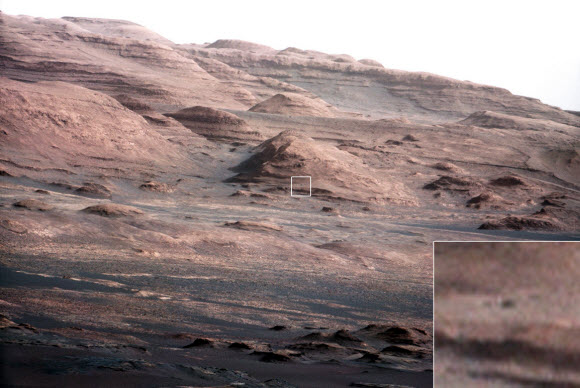
 |
THE GEOLOGY OF MARSFriday, November 22, 2013 at Benedictine University |
|---|
Assoc. Prof. Paul Stoddard |
 |
|
|
Pre-Dinner Talk:
|
|
Benedictine University
Krasa Center/Student Union 2nd Floor
5700 College Rd
Lisle, IL 60532
map map25:30 - 7:00 PM · Social Hour
6:00 · 6:20 PM · Pre-Dinner Talk by Tim Marin
7:00 - 8:00 PM · Dinner
8:00 PM · General Meeting and Main Talk by Paul Stoddard
Cost: $15
You may register for the meeting with our traditional registration page or scroll to the bottom of this page to order tickets, where you can pay with a credit card.
Deadline is noon Thursday, November 21
Please contact the Section Office if you have problems registering (847-391-9091, chicagoacs@ameritech.net)
 Abstract: Mars has long held the attention of astronomers, exobiologists, science fiction writers, and the public at large. From early, albeit incorrect, reports of extensive canal systems, to thirsty invaders, to Martian meteorites, to Spirit, Opportunity, and Curiosity, Mars seems never far from our consciousness. We will take an overview of the exploration of Mars, focusing on the search for signs of Martian water, environments capable of sustaining life, and life itself. Specific mention will be made of the Mariner missions, Vikings I and II, and of course, the current fleet of rovers. We will talk of the geologic history of Mars, and compare it to that of Earth. We will summarize the talk by examining the implications of the above topics for our chances of finding life on Mars.
Abstract: Mars has long held the attention of astronomers, exobiologists, science fiction writers, and the public at large. From early, albeit incorrect, reports of extensive canal systems, to thirsty invaders, to Martian meteorites, to Spirit, Opportunity, and Curiosity, Mars seems never far from our consciousness. We will take an overview of the exploration of Mars, focusing on the search for signs of Martian water, environments capable of sustaining life, and life itself. Specific mention will be made of the Mariner missions, Vikings I and II, and of course, the current fleet of rovers. We will talk of the geologic history of Mars, and compare it to that of Earth. We will summarize the talk by examining the implications of the above topics for our chances of finding life on Mars.
 Abstract: We propose that the paucity of organic compounds in martian soil can be accounted for by efficient photocatalytic decomposition of carboxylated molecules due to the occurrence of the photo-Kolbe reaction at the surface of particulate iron(III) oxides that are abundant in the martian regolith. This photoreaction is initiated by the absorption of UVA light, and it readily occurs even at low temperature. The decarboxylation is observed for miscellaneous organic carboxylates, including the nonvolatile products of kerogen oxidation (that are currently thought to accumulate in the soil) as well as a-amino acids and peptides. Our study indicates that there may be no ‘‘safe haven’’ for these organic compounds on Mars; oxidation by reactive radicals, such as hydroxyl, is concerted with photocatalytic reactions on the oxide particles. Acting together, these two mechanisms result in mineralization of the organic component. The photooxidation of acetate (the terminal product of radical oxidation of the aliphatic component of kerogen) on the iron(III) oxides results in the formation of methane; this reaction may account for seasonably variable production of methane on Mars. The concomitant reduction of Fe(III) in the regolith leads to the formation of highly soluble ferrous ions that contribute to weathering of the soil particles.
Abstract: We propose that the paucity of organic compounds in martian soil can be accounted for by efficient photocatalytic decomposition of carboxylated molecules due to the occurrence of the photo-Kolbe reaction at the surface of particulate iron(III) oxides that are abundant in the martian regolith. This photoreaction is initiated by the absorption of UVA light, and it readily occurs even at low temperature. The decarboxylation is observed for miscellaneous organic carboxylates, including the nonvolatile products of kerogen oxidation (that are currently thought to accumulate in the soil) as well as a-amino acids and peptides. Our study indicates that there may be no ‘‘safe haven’’ for these organic compounds on Mars; oxidation by reactive radicals, such as hydroxyl, is concerted with photocatalytic reactions on the oxide particles. Acting together, these two mechanisms result in mineralization of the organic component. The photooxidation of acetate (the terminal product of radical oxidation of the aliphatic component of kerogen) on the iron(III) oxides results in the formation of methane; this reaction may account for seasonably variable production of methane on Mars. The concomitant reduction of Fe(III) in the regolith leads to the formation of highly soluble ferrous ions that contribute to weathering of the soil particles.
|
(Click here for traditional map with general directions) PUBLIC TRANSPORTATION: |
(click for full pdf) |
Buffet Dinner:
Associate Professor Paul Stoddard works in the Geology and Environmental Geosciences Department at Northern Illinois University, specializing in plate tectonics, geodynamics, and planetary geology. He earned his Ph.D. in Geological Sciences from Northwestern University,where his thesis was entitled "Kinematic Studies: Ridge Evolution, Gorda Plate, and the Deccan Traps" He earned his A.B. in Geology/Physics-Math from Brown Univeristy, and his M.Sc. from Texas A&M, where his thesis was " Deformation of the Gorda Block of the Juan De Fuca Plate". Between his M.Sc. and Ph.D., he worked at Conoco, Inc., as a geophysicist.
Associate Professor Tim Marin is Chair of the Departments of Chemistry and Physics at Benedictine University and works in the Physical Chemistry division. He received a B.S. in chemistry from Benedictine University, and his M.S. and Ph.D. degrees from Northwestern University in chemical and molecular physics. Dr. Marin’s teaching responsibilities have included the physical chemistry curriculum as well as the general chemistry course sequence. Dr. Marin holds an appointment at nearby Argonne National Laboratory in the Chemical Sciences and Engineering division, where he engages in government research primarily involving radiation-induced processes in advanced nuclear fuel cycling. He also holds an active collaboration with the Notre Dame Radiation Laboratory and the Synchrotron Radiation Center at the University of Wisconsin-Madison, working to ascertain the fundamental properties of water under extreme temperature and pressure conditions. He has received two major awards from Benedictine: the Distinguished Faculty Award for Research in 2009, and the College of Science Dean's Award for Research in 2008.
| Last updated 10/31/13 Copyright © 2009-2013, Chicago Section, The American Chemical Society |
Webs by Wizardcraft |